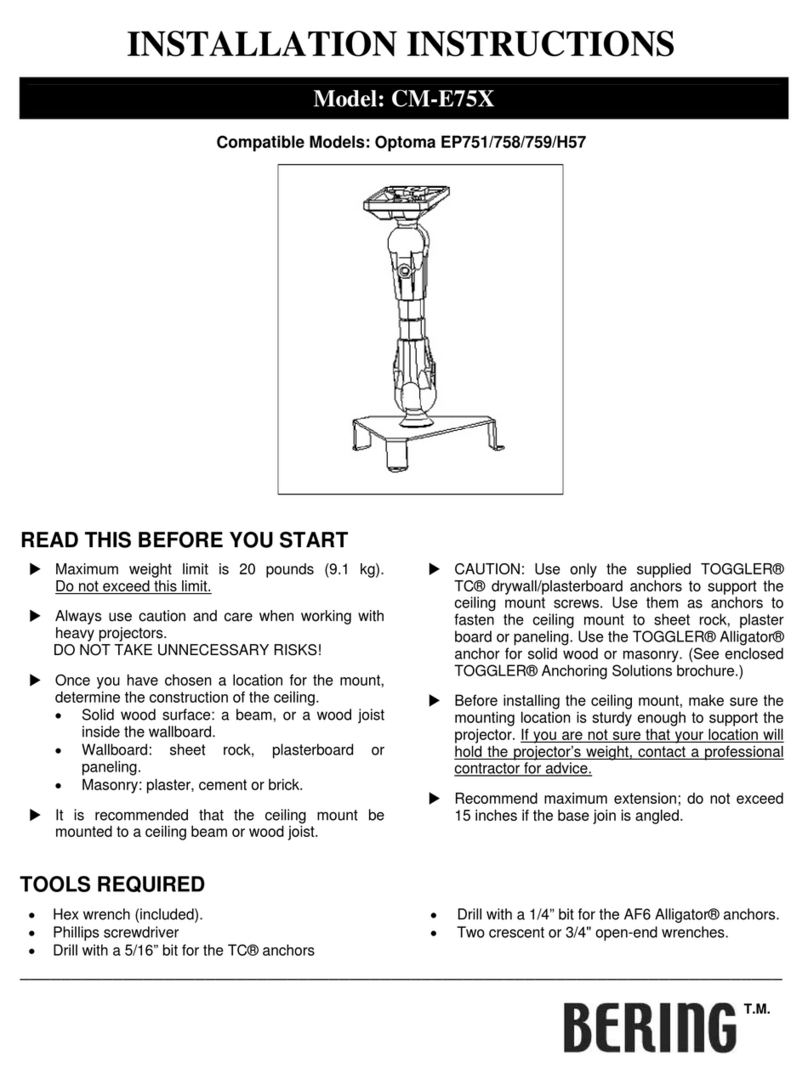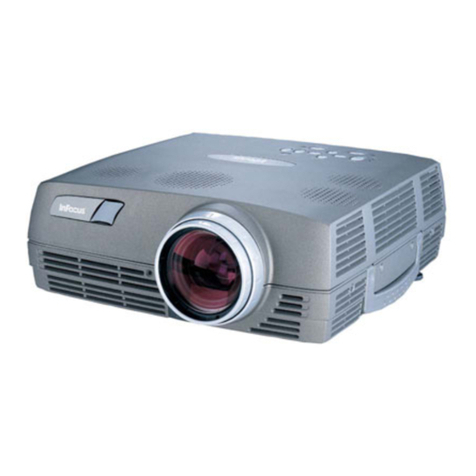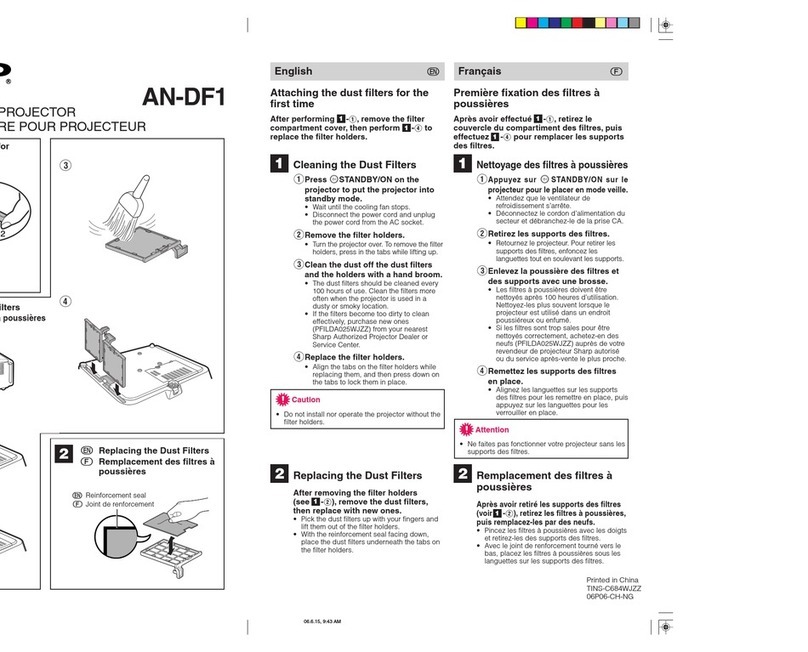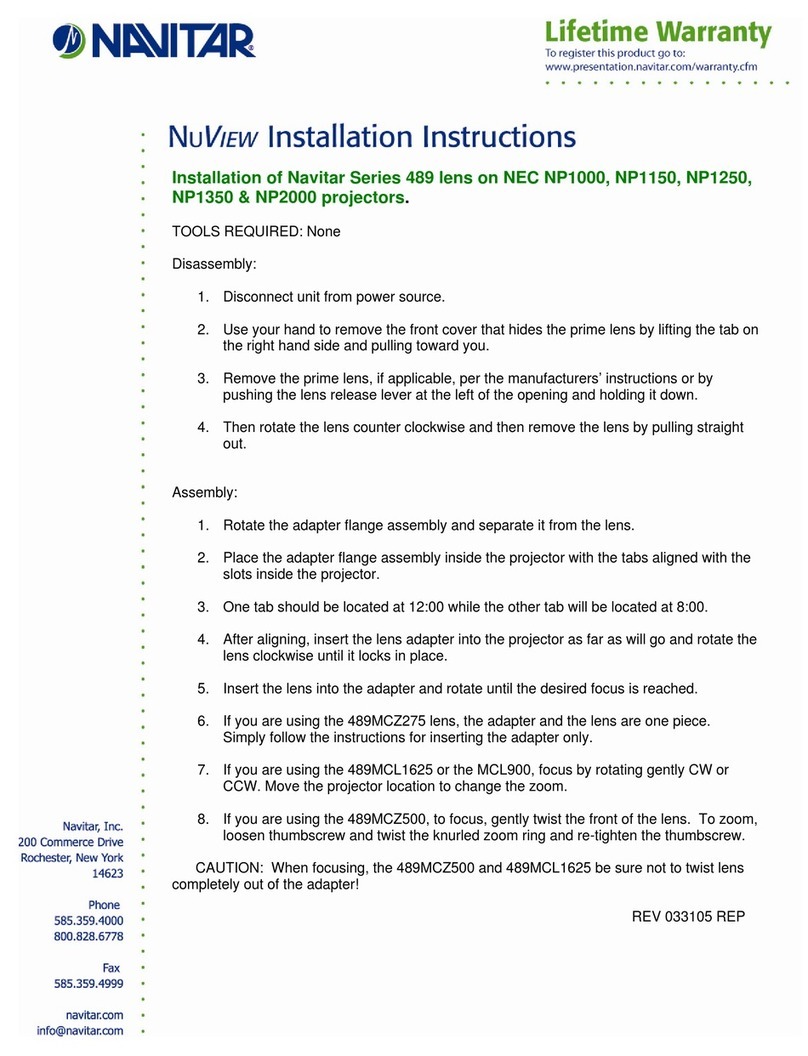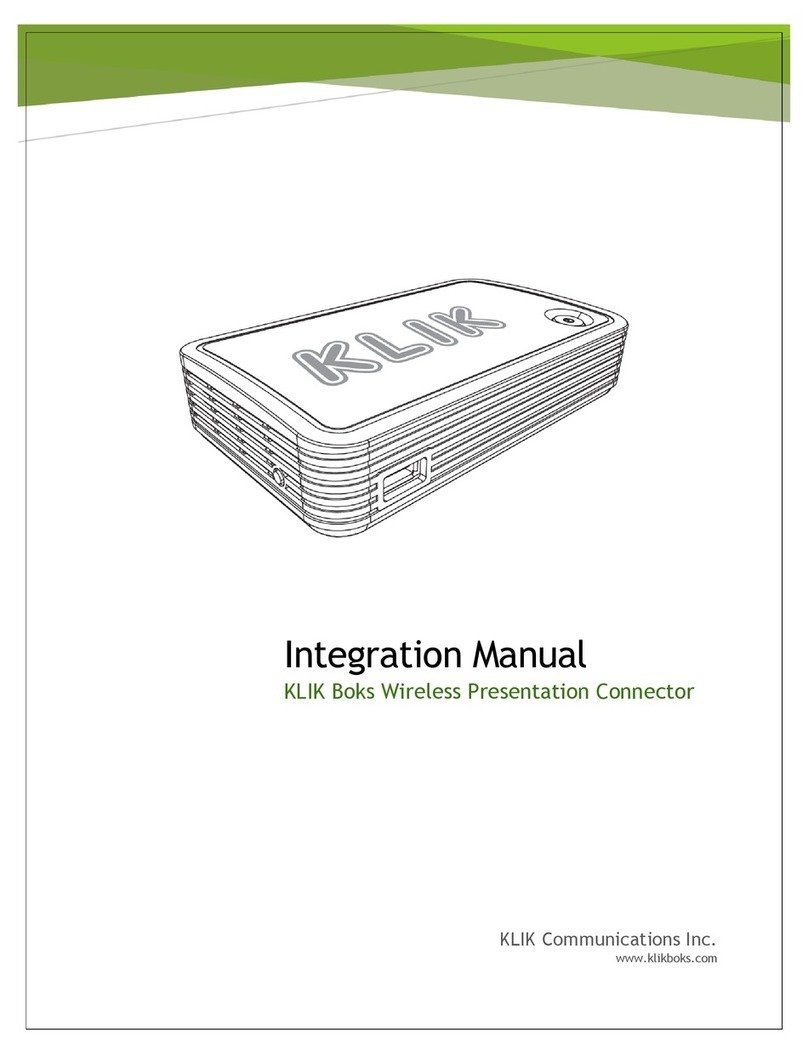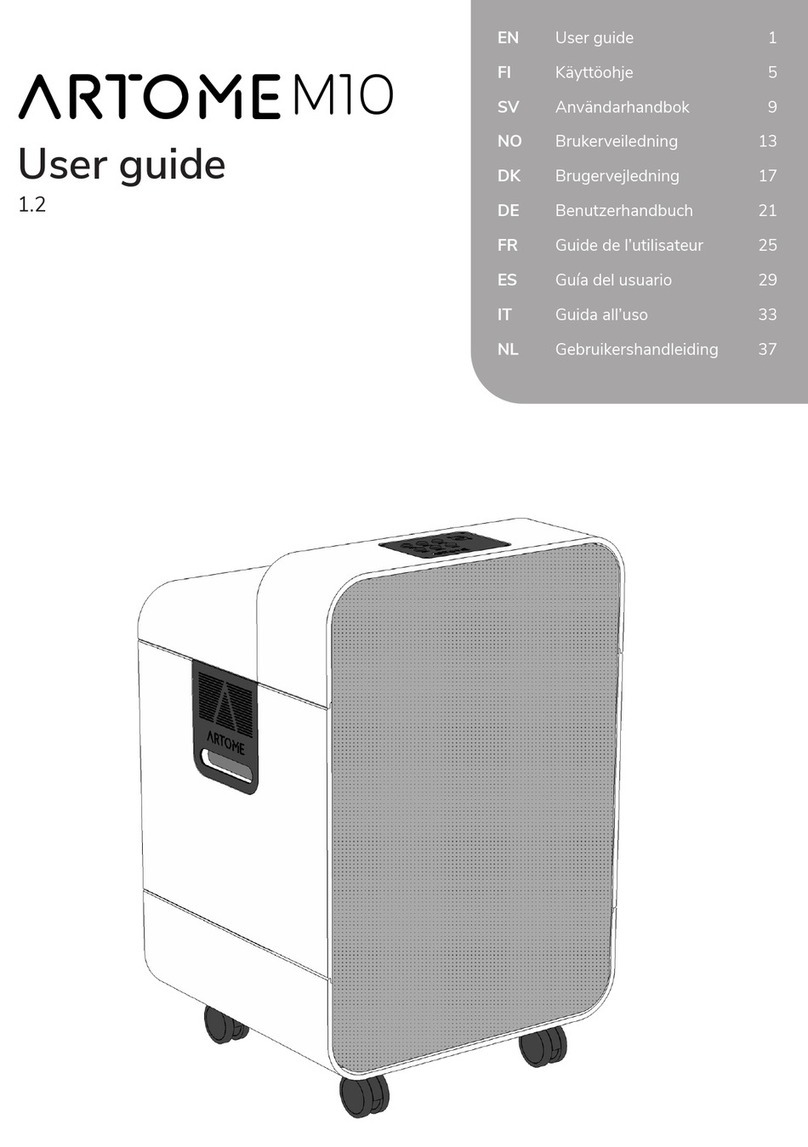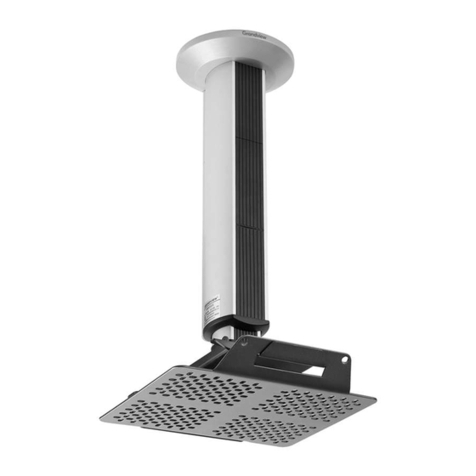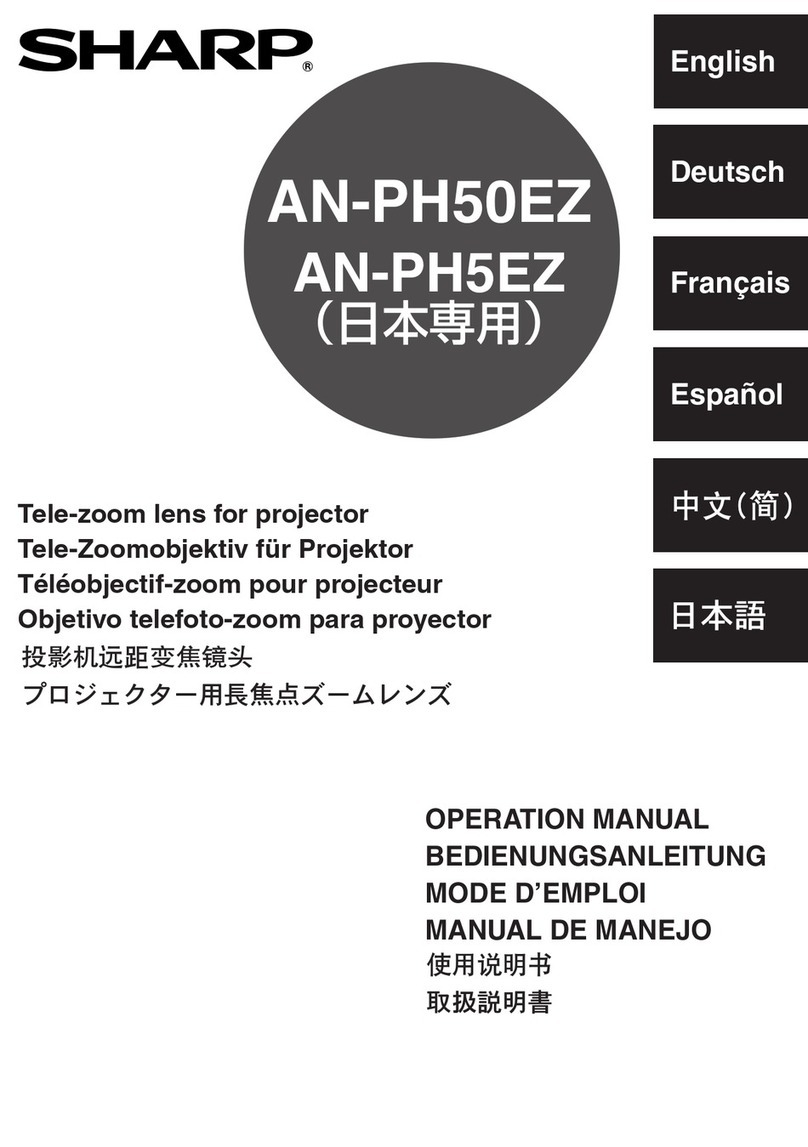JED T430 User manual

T440 User’s manual V096B, © JED Microprocessors Pty Ltd Jan 20
th
2015 Page 1
JED T430/T440 Projector Controller user’s manual version V097P part B
(Ed Schoell rev Mar 17th 2015… Projector only code version)
Table of Contents
Acer projector family 1
BenQ MP5/7xx, SP820,Opt. Gr3 3/7
Canon 8
Casio XJ-M 9/10
Dell 11
Eiki XDP-3500, XIP-2600 12
Epson VP21, IR to S/W/X5… 13/16
HP projector 17
Hitachi proj 18/19
InFocus / ASK Proxima 20/23
Mitsubishi 24/26
NEC Projector 27/29
Optoma Projector Gr.1,2,4,5 30/33
Panasonic Projector 34/36
Plus: U5, U7 37
ProjectionDesign & Christie 38/39
Promethean PRM-10, 20A 38
Ricoh 40
Sanyo/Eiki 41/47
Sharp 48
Smart projector 49
Sony projector RS232/IR 50/51
Toshiba projector 52/54
Taxan/Kaga KG-PV-131S/
PS-232 55/57
ViewSonic 58/61
Vivitek, Promethean PRM25 62/64
Acer (Code 70 hex, DVI-I, Code 71, HDMI at 9600,
Code 72 hex, DVI-I, Code 73, HDMI at 115200 baud)
There are many Acer projectors covered by this driver … all use common codes, but vary as to sources supported.
Drivers 70 and 72 support DVI-D and DVI-A as video 2, Computer 2, and 71 and 72 support HDMI. Baud rates of
9600 are supported by codes 70 and 71, and 115200 by code 72 and 73. Some have RGB2, but no codes for this source
are published (Most RGB2 is actually via a DVI-A interface, it seems).
Acer projectors are shown in groups which have similar properties and protocol ... HDMI at the front of a group
indicates that group as an HDMI interface rather than DVI, and so codes 71 and 73 should be used for these. As for
baud rate, initially models shown below in bold are 115200 bps, but several manuals show that during production of a
particular model, the baud rate changed to 9600. The best option is to try 9600 settings first (codes 70 and 71) and if
that does not work, try at 115200 (codes 72 and 73.)
A: HDMI S5200, S5201/B, P5205, P5206, S5201/B, P5301/WB, P5270,
P5271/i, P5290/W, P5390W, P7201, P7209,
P7270i, P7280
B: HDMI P1100/C, P1200/i/B/C/n, P1201B, P1203, P1206, P1303
C: M114, M112
D: HDMI 115200 X1110, X1210, X1210S/K, X1213, D315, S21T, D302, X1111/H/A, X1211/H/S/K, X1213P/PH,
X1311KW, X1313PW/PWH
E: X1161/A/N, X1261, X110, H5360, D110
F: HDMI P7200, P7203, P7205, P7500
G: HDMI 115200 X1130P/PS, X1120PK, X1230S/PK/PS, X1235, X1237
H: HDMI H7530, H7531
I: HDMI X1120, X1220H, X1320WH
J: HDMI H9500/BD
K: DVI:XD1170, DVI:XD1270, XD1280
Channel codes are:
Input1 := '* 0 IR 015' + 0D; //Computer1 RGB analog-RGB VGA DB9/1
Input2 := '* 0 IR 028' + 0D; //Computer2 RGB analog- via DVI-A or DB9/2
Input3 := '* 0 IR 019' + 0D; //Video1 Comp Video
Input4 := '* 0 IR 016' + 0D; //Video2 DVI-D (Codes 70, 72) Use OPT1 On for DVI-D for main video.
or
Input4 := '* 0 IR 050' + 0D; //Video2 HDMI (Codes 71, 73) Use OPT1 On for HDMI for main video.
* T440: OPT6 switch ON will use S-Video in place of HDMI/DVI. T430: Uses HDMI for Video2

T440 User’s manual V096B, © JED Microprocessors Pty Ltd Jan 20
th
2015 Page 2
Input5 := '* 0 IR 017' + 0D; // Component YPbPr via DB15 HDTV
Input6 := '* 0 IR 029' + 0D; // Component YPbPr DVI or HDMI via adaptor
Any one of these codes can be set into Constant:0/Constant:1 for computer codes and Constant:2/Constant:3 for video
codes. (The default is to have Computer1 (above) as the “Computer” channel and Video1 as the “Video” channel.
Setting OPT1 switch ON will swap Video1 and Video2 channels, making S-Video the video default. Setting OPT5 will
swap Computer1 and Computer2. Setting OPT4 will allow double- presses on some keyboards.).
•Power on projector connection blink codes available;
•OPT7 handshake mode not available;
•Source lock must be turned ON in the “Maintenance” menu;
•Freeze and mute are toggle mode only in these projectors, so 2-yellow-button mute mode is NOT supported;
•Audio functions are limited to one (sometimes two) audio input(s) and no output to room speakers on most. Use a
T441/T461 if audio control is needed;
•The Volume level indication bar does NOT appear on the projected image screen UNLESS a valid
video/VGA/HDMI image is being shown at the time. Commands are ignored;
•Volume processing time is 600ms per increment via RS232, and we have provided auto-incrementing to the
Volume Up and Volume Down buttons, but it takes 1 minute (100 x 600ms) to ramp from 0 to 100 audio level.
RS232 connections to 3-Pin DIN Acer projectors
(Note some seem to have DB9 connector. Use a multimeter to determine the connections … -5 to -9 volts indicates the
projector Tx output, and the other pin (of 2 & 3) is the T440/T430 Tx input to the projector).
Mini-DIN 3 socket on projector. Comms at: 9600 DP8N1 or at 115,200.
Function/Direction
T440 “projector”
Connection
Acer Serial Port
Connector
Ground Ground Mini-DIN 3 pin 3 (Gnd)
Data from T440 to projector Tx Mini-DIN 3 pin 1 or 2 (RXD)
Reply data from projector to T440 Rx Mini-DIN 3 pin 2 or 1 (TXD)
After installation wiring of any projector to a T440, use a multimeter to check voltages of –9 on BOTH TX and RX pins
in any installation, as described in the troubleshooting part of this manual.
Mini-DIN 3
solder side
3
21

T440 User’s manual V096B, © JED Microprocessors Pty Ltd Jan 20
th
2015 Page 3
BenQ SH960 (Code 3D hex)
Channel codes for this is:
Input1 := '*sour=RGB#'; // Computer1 Analog RGB DB15
Input2 := '*sour=ypbr#'; // Component RGB via RCA
Input3 := '*sour=vid#'; // Video1 Composite Video RCA * (OPT1 swaps Video1 & Video2)
Input4 := '*sour=hdmi#'; // Video2 HDMI * (OPT1 swaps Video1 & Video2)
or
Input4 := '*sour=svid#'; //Video2 S-Video
* T440: OPT6 switch ON will use S-Video in place of HDMI. T430: uses HDMI as Video 2.
Input5 := '*sour=RGB2#'; // Component via DB15
Any one of these codes can be set into Constant:0/Constant:1 for computer codes and Constant:2/Constant:3 for video
codes. (The default is to have Computer1 (above) as the “Computer” channel and Video1 as the “Video” channel.
Setting OPT1 switch ON will swap Video1 and Video2 channels, making HDMI the video default. Setting OPT5 will
swap Computer1 and Computer2. Setting OPT4 will allow double- presses on some keyboards.).
OPT7 handshake mode not available;
•Power on panel connection blink codes available;
•In System Setup: “Auto Power Off” -> “Disable, “Sleep Time” -> Disable, “Quick Auto Search” -> Off;
•In Advanced Setup: In Lan Control Settings -> Control by RS232;
•In Advanced Setup: In Baud rate -> 19200;
•In Advanced Setup: Direct Power On -> Set OFF, Direct Power Off -> Set OFF
•Audio functions are limited to one audio input and no output. Use a T441/T461 if audio control is needed.
SP870( Rev 2.13) (Code 37 hex)
Input1 := 0D + '*sour=rgb#' + 0D //Computer1 Analog RGB DB15
Input2 := 0D + '*sour=dvid#' + 0D; //Computer2 DVI-D (Digital)
Input3 := 0D + '*sour=vid#' + 0D; //Video1 Composite Video RCA (OPT1 swaps Video1 & Video2)
Input4 := 0D + '*sour=dvid#' + 0D; //Video 2 DVI-D (Digital)* (OPT1 swaps Video1 & Video2)
* T440: OPT6 switch ON will use S-Video in place of HDMI/DVI. T430: Uses DVI-D as Video2
Input4 := 0D + '*sour=svid#' + 0D; //Video2 S-Video*
Input5 := 0D + '*sour=ypbr#' + 0D; // Component
Input6 := 0D + '*sour=dvid#' + 0D; // DVI-D (Digital)
BenQ projectors: RS232 Connection: lots, inc. SH960, MP722, MP723, MP771,
SP870, SP920
(Communications runs at 19200 8N1. Projectors use a male 8-pin mini-DIN on the cable
Function
T440 “projector”
Connection
DIN 8
-
pin BenQ,
Ground Pin 1 Pin 4
Serial TX out to projector Pin 2 Pin 1
Serial RX into T440 from proj. Pin 3 Pin 7
CTS out to projector Pin 4 Not used
After installation wiring of any projector to a T440, use a multimeter to check voltages of –9 on BOTH TX and RX pins
in any installation, as described in the troubleshooting part of this manual.
Mini-DIN 8
solder side
43 5
1 2
6 7 8

T440 User’s manual V096B, © JED Microprocessors Pty Ltd Jan 20
th
2015 Page 4
BenQ MP724, MP727, MP735 (Code 3E hex)
Channel codes for these are:
Input1 := 0D + '*sour=RGB#' + 0D; //Computer1 Analog RGB DB15
Input2 := 0D + '*sour=dviA#' + 0D; //Computer2 DVI-A (Analog)
Input3 := 0D + '*sour=vid#' + 0D; //Video1 Composite Video RCA (OPT1 swaps Video1 & Video2)
Input4 := 0D + '*sour= hdmi #' + 0D; //Video 2 DVI-D (Digital)* (OPT1 swaps Video1 & Video2)
* T440: OPT6 switch ON will use S-Video in place of HDMI/DVI. T430: Uses DVI-D for Video2
Input4 := 0D + '*sour=svid#' + 0D; //Video2 S-Video*
Input5 := 0D + '*sour=ypbr#' + 0D; // Component
Input6 := 0D + '*sour=dvid#' + 0D; // DVI-D (Digital)
Input7 := 0D + '*sour=hdmi#' + 0D; // HDMI
Any one of these codes can be set into Constant:0/Constant:1 for computer codes and Constant:2/Constant:3 for video
codes. (The default is to have Computer1 (above) as the “Computer” channel and Video1 as the “Video” channel.
Setting OPT1 switch ON will swap Video1 and Video2 channels, making S-Video the video default. Setting OPT5 will
swap Computer1 and Computer2. Setting OPT4 will allow double- presses on some keyboards.).
•OPT7 handshake mode and power on panel connection blink codes available ;
•Source scan must be turned off using normal on-screen menu options;
•RS232 communications must be enabled and baud rate set to 19200 in the SYSTEM SETUP: Advanced menu;
•Freeze and mute are toggle mode in these projectors (despite the manual stating absolute commands: this is a lie!),
but status read-back is provided and used in the T440 driver to simulate absolute mute commands. Thus 2-yellow-
button mute mode is supported on keyboard codes 2, 9 and BL/P, both with projector internal audio and T441/T461
audio: OPT7 must be ON for this;
•Audio functions have one RCA pair for Video/S-Video, one 3.5mm jack for both computers and a stereo 3.5mm
output with controlled audio. Use a T441/T461 if more audio control is needed. (On the test device we found audio
limited, with only 10 audio levels and an unexplained stopping of all audio.)
RS232 connections to BenQ MP724, MP727, MP735 with D9
These use a 9-pin-D9 male on the proj, female on cable. Comms is at 19200 baud, 8 N1.
Function/Direction
T440 “projector”
Connection
“Serial” Port Connector
Ground Ground 9-pin D-sub pin 5
Data from T440 to projector Tx 9-pin D-sub pin 2 (RXD)
Reply data from projector to T440 Rx 9-pin D-sub pin 3 (TXD)
Plus 9 volt CTS/DTR to projector n/c n/c
After installation wiring of any projector to a T440, use a multimeter to check voltages of –9 on BOTH TX and RX pins
in any installation, as described in the troubleshooting part of this manual.
8
1 2 3 4 5
6 7 9
D-sub 9 female
solder side

T440 User’s manual V096B, © JED Microprocessors Pty Ltd Jan 20
th
2015 Page 5
BenQ MP512 MP513, MP522, MP626, MP623, MP624, MP670, MP772st, MP776st,
MP777, MX750/MP780st, SP920 (Code 3F allows HDMI for Computer: 2, Code 4A allows
HDMI for Video 2 or 1, RGB2 for Computer:2)
MP551 (Code 4B hex), MP525/MP525P/MP575, MP626/MP576 (No HDMI/RGB2),
MP515ST/MP525ST (HDMI version) (Code 4C)
*MS614, MW714st / MW811st, MX615, MX660P, MX710 / MX711, MX713ST / MX810ST,
MX762ST / MX812ST, MX763, MX764, MX760 / MX761, MX712UST / MX880UST,
MX716/MX717 (Code 7C with Vid2->S-Video, Code 7F with Vid2->HDMI)
*SP840, W600 (2 x HDMI, allows HDMI1 for Video and HDMI2 for Computer, Code 7D)
* Note: Most recent BenQ fit into these categories. Try these with unknown BenQ units.
Channel codes for these are:
Input1 := 0D + '*sour=RGB#' + 0D; //Computer1 Analog RGB DB15 (some YPbPr1)
Input2 := 0D + '*sour=hdmi#' + 0D; //Computer2 HDMI Code <<<<<<<<<<< 3F, 4C hex
or
Input2 := 0D + '*sour=RGB2#' + 0D; //Computer2 Analog RGB DB15 no 2 <<< 4A, 4B, 7C hex
or
Input2 := 0D + '*sour=hdmi2#' +$0D; //Computer2 HDMI 2 <<< 7D hex
Input3 := 0D + '*sour=vid#' + 0D; //Video1 Composite Video RCA (OPT1 swaps Video1 & Video2)
Input4 := 0D + '*sour= hdmi #' + 0D; //Video 2 DVI-D (Digital)* (OPT1 swaps Video1 & Video2)
* T440: OPT6 switch ON will use S-Video in place of HDMI/DVI. T430: Uses HDMI for Video2
Input4 := 0D + '*sour=svid#' + 0D; //Video2 S-Video*
Input5 := 0D + '*sour=ypbr#' + 0D; // Component
Input6 := 0D + '*sour=dviA#' + 0D; // DVI-A (Analog)
Input7 := 0D + '*sour=dviD #' + 0D; // HDMI (Digital)
Input8 := 0D + '*sour=hdmi#' + 0D; // HDMI
Input9 := 0D + '*sour=hdmi2#' + 0D; // HDMI 2
Input10 := 0D + '*sour=RGB2#' + 0D; // Computer2 Analog RGB DB15
Input11 := 0D + '*sour=net#' + 0D; // network
Input12 := 0D + '*sour=svid#' + 0D; //Video2 S-Video
Any one of these codes can be set into Constant:0/Constant:1 for computer codes and Constant:2/Constant:3 for video
codes. (The default is to have Computer1 (above) as the “Computer” channel and Video1 as the “Video” channel.
Setting OPT1 switch ON will swap Video1 and Video2 channels, making S-Video the video default. Setting OPT5 will
swap Computer1 and Computer2. Setting OPT4 will allow double- presses on some keyboards.).
NOTE: Tests of the MP525ST have revealed an intermittent failure to communicate in the “standby” state, showing up
as a failure to respond to the communications test (pushing the RED OFF key and watching ONE flash, not three) and a
failure to start. This would appear to be fixed by entering factory setup mode and turning “Full Power Standby” to ON.
•OPT7 handshake mode and power on panel connection blink codes available for code 3F, 4A, 7C and 7F family,
but ONLY power-on-blink for code 4B and 4C projectors;
•“Source scan”, or “Quick Auto Search” must be turned off using normal on-screen menu options;
•RS232 communications must be enabled (some only) and baud rate set to 19200 in the “System Setup:
Advanced” menu. If this is not done, you will NOT communicate!;
•In “System Setup: Advanced” | Standby Settings | press Enter, then set “Network” to ON to enable RS232 coms.
•Audio functions on some are limited to one audio input and no output, although it seems the MP626/MP670 and
MP870st does have 2 audio ins and correctly controlled audio OUT. (Use a T441/T461 if audio control is needed;)

T440 User’s manual V096B, © JED Microprocessors Pty Ltd Jan 20
th
2015 Page 6
•Freeze and mute are absolute in these projectors, and 2-yellow-button mute mode is supported when running with a
T441/T461 doing audio control. It is supported on the MP626, MP670, MP780st, MW714st and MW811st with
their limited audio. (The last two have only one audio channel, with no audio on RGB inputs);
•Turn OFF “Auto-Power-On”, so the projector does not auto-start when power is cycled or drops out with power
failures.
On some which do not have a standby select mode:
1. Using keypad:
a) Press “Menu” on keypad
b) When showing main menu, press "Source" + "Mode" at the same time
c) Factory menu popup at the top - left of display
2. In factory mode, use “Down” arrow and change “Full Power Standby” to “ON”. Push “Menu” twice to exit
Aspect ratio setting for BenQ family
The aspect ratio codes for these BenQ projectors are the same, but are interpreted differently with different models.
Note that to use these, enable bits for ratios usable by each channel must be set into UserFlags[0..3] and the preselected
or “default” aspect setting must be set into UserFlags[5..8]
SetAspect1 := 0D + '*asp=4:3#' + 0D; // Reg 4:3
SetAspect2 := 0D + '*asp=16:9#' + 0D; // 16:9
(Note that initial aspect ratio commands do not appear to be accepted if there is no signal input to that channel.)
RS232 connections to BenQ projectors with D9, MP623, MP624, MW714st / MW811st,
MX710 / MX711, MX760 / MX761 etc, MP780st
These all use a D-sub 9-pin connector, female on projector, male on cable. Communications runs at 19200 8N1.
Function/Direction
T440 “projector”
Connection
Projector Connector
(Male on cable)
Ground Ground 9-pin D-sub pin 5
Data from T440 to projector Tx 9-pin D-sub pin 2 (RXD)
Reply data from projector to T440 Rx 9-pin D-sub pin 3 (TXD)
Plus 9 volt CTS/DTR to projector N/C N/C
After installation wiring of any projector to a T440, use a multimeter to check voltages of –9 on BOTH TX and RX pins
in any installation, as described in the troubleshooting part of this manual.
3
D-sub 9 male
solder side
4 25 1
9 8 7 6

T440 User’s manual V096B, © JED Microprocessors Pty Ltd Jan 20
th
2015 Page 7
BenQ SP820, Optoma Group 5: EP771, EP772, EP774 projectors (Code 3B hex)
(Message formats are ASCII with format: “~PN<CR>” for Power On, “~SR<CR>” for RGB select, etc.)
Channel codes are:
Input1 := '~SR' + 0D; //Computer1 RGB analog-RGB VGA
Input2 := '~SD' + 0D; //Computer2 DVI
Input3 := '~SV' + 0D; //Video1 Comp Video (OPT1 swaps Video1 & Video2)
Input4 := '~SH' + 0D; //Video2 HDMI * (OPT1 swaps Video1 & Video2)
* T440: OPT6 switch ON will use S-Video in place of HDMI/DVI. T430: Uses HDMI for Video2.
Input4 := '~SS' + 0D; //Video2 S-Video *
Input5 := '~SY' + 0D; // Component via DB15
Input6 := '~SH' + 0D; // HDMI
Input7 := '~SG' + 0D; // Computer2 RGB analog-RGB VGA
Input8 := '~SD' + 0D; // Computer2 DVI for Vivitek use
Input9 := '~SW' + 0D; // Wireless
Any one of these codes can be set into Constant:0/Constant:1 for computer codes and Constant:2/Constant:3 for video
codes. (The default is to have Computer1 (above) as the “Computer” channel and Video1 as the “Video” channel.
Setting OPT1 switch ON will swap Video1 and Video2 channels, making S-Video the video default. Setting OPT5 will
swap Computer1 and Computer2. Setting OPT4 will allow double- presses on some keyboards.).
•OPT7 handshake mode and power on panel connection blink codes available;
•You must turn off “Auto Source” in “Config” menu;
•You must turn off “Auto Power Off” and ‘Direct Power On” in “Config” menu.
•Freeze and mute toggle only with the “Freeze/Mute” keyboard. No LEDs flash in the “Mute” state. No 2-yellow-
button mute is provided with a “Volume” keyboard as the limited projector codes cannot command absolutely or
read back the mute state;
RS232 connections to BenQ SP820, Optoma EP771/772 projector with D9
These use a 9-pin-D9 male on the proj, female on cable. Comms is at 9600 baud, 8 bits, no parity, 1 stop.
Function/Direction
T440 “projector”
Connection
“Serial” Port Connector
Ground Ground 9-pin D-sub pin 5
Data from T440 to projector Tx 9-pin D-sub pin 3 (RXD)
Reply data from projector to T440 Rx 9-pin D-sub pin 2 (TXD)
Plus 9 volt CTS/DTR to projector n/c n/c
After installation wiring of any projector to a T440, use a multimeter to check voltages of –9 on BOTH TX and
RX pins in any installation, as described in the troubleshooting part of this manual.
8
1 2 3 4 5
6 7 9
D-sub 9 female
solder side

T440 User’s manual V096B, © JED Microprocessors Pty Ltd Jan 20
th
2015 Page 8
Canon:
SX6000/WX6000, SX80 MkII / SX800, WUX10 Mk II (Code 1C hex)
WUX4000/WUX5000 (Code 1D hex)
(Message formats are ASCII)
Channel codes are:
Input1 := 'INPUT=A-RGB1' + 0D; // Computer1 on DB9 (Shared with Component in) (Code $1C)
or
Input1 := 'INPUT=A-RGB' + 0D; // no RBG2 (On DVI) (Code $1D)
Input2 := 'INPUT=A-RGB2' + 0D; // Computer2 on DVI-I INPUT (Code $1C)
or
Input2 := 'INPUT=D-RGB' + 0D; // no RBG2 (On DVI) (Code $1D)
Input3 := 'INPUT=HDMI' + 0D; // HDMI
Input4 := 'INPUT=VIDEO' + 0D; // Video1
Input5 := 'INPUT=COMP' + 0D; // Component
Input6 := 'INPUT=S-VIDEO' + 0D;
Input7 := 'INPUT=D-RGB' + 0D; // DVI-D
Input8 := 'INPUT=USB' + 0D; //USB
Any one of these codes can be set into Constant:0/Constant:1 for computer codes and Constant:2/Constant:3 for video
codes. (The default is to have Computer1 (above) as the “Computer” channel and Video1 as the “Video” channel.
Setting OPT1 switch ON will swap Video1 and Video2 channels. Setting OPT5 will swap Computer1 and Computer2.
Setting OPT4 will allow double- presses on some keyboards.)
This projector has not been tested live, so feedback on operation, including warm-up times and cooldown times would
be welcome.
•Power on panel connection blink code is available. (Please confirm if this works OK);
•There may well be auto-source functions to turn off and standby mode to setup to enable RS232. These are not
mentioned in the manual.
These projectors use a D9 connector, so check the connections in the manual. After, use a multimeter to check
voltages of –9 on BOTH TX and RX pins in any installation, as described in the troubleshooting part of this
manual.

T440 User’s manual V096B, © JED Microprocessors Pty Ltd Jan 20
th
2015 Page 9
Casio XJ-M, (also XJ-A) series projectors (LED/Laser) (Code 6D hex), XJ-H (6E hex)
Includes XJ-M140/XJ-M145, XJ-M240/XJ-M245, XJ-M150/XJ-M155, XJ-M250/XJ-M255,
XJ-H1600, XJ-H1650
Other XJ series seem to use same codes & speed, but are untested. (They have various inputs.)
Manual, with codes are at: http://support.casio.com/pdf/007/UsersGuide_XJM_E.pdf
and: http://support.casio.com/pdf/007/UsersGuide_XJHST_E.pdf
Channel codes are:
Input1 := '(SRC0)'; // (all) Computer1 "Computer In", DSUB15 VGA / RGB
Input2 := '(SRC7)'; //(XJ-M) Computer2 "HDMI" (XJ-M, XJ-A)
or
Input2 := '(SRC3)'; // (XJ-H) Computer2 “RGB2” (XJ-H)
Input3 := '(SRC2)'; // (all) Video1 RCA Composite (OPT1 swaps Video1 & Video2)
Input4 := '(SRC7)'; // (all) Video2 HDMI * (OPT1 swaps Video1 & Video2)
* T440: OPT6 switch ON will use S-Video in place of HDMI/DVI. T430: uses HDMI for Video2
Input4 := '(SRC9)'; // (all) Video2 S-Video *
Input5 := '(SRC1)'; // (all) Component 1
Input6 := '(SRC4)'; // (XJ-H) Component 2
Input7 := '(SRC6)'; // (all) Auto 1 (RGB1/Component1)
Input8 := '(SRC10)'; // (XJ-H) Auto 2 (RGB2/Component2)
Input9 := '(SRC7)'; // (all) HDMI
Input10 := '(SRC5)'; // (all)USB (OR Wireless)
Any one of these codes can be set into Constant:0/Constant:1 for computer codes and Constant:2/Constant:3 for video
codes. (The default is to have Computer1 (above) as the “Computer” channel and Video1 as the “Video” channel.
Setting OPT1 switch ON will swap Video1 and Video2 channels, making S-Video the video default.
Setting OPT5 will swap Computer1 and Computer2.
Setting OPT4 will allow double- presses on some keyboards..
•OPT7 handshake mode and power on panel connection blink codes available;
•You must turn off “Auto Source” in “Config” menu;
•You must turn off “Direct Power On” in “Option settings 1” menu.
•Mute on/off only with the “Freeze/Mute” keyboard. Two-yellow button “Mute” command is supported;
•These typically have one PC audio, one Video audio and one HDMI audio input. Audio volume control from the
T440 (or the set-top menu) controls audio to the internal 2” speaker. However, the audio output from the line-
output connector is NOT controlled. For audio level control, use a JED T441 (2-channel) or a T461 (4-channel)
audio system. (You must select Audio to “Line” in the “Option Settings 2”, then “Audio Out” menus.)
Aspect ratio control
SetAspect1 := '(ARZ0)'; // 4:3 "Normal" RGB or HDMI(PC)
SetAspect2 := '(ARZ1)'; // 16:9 *
SetAspect3 := '(ARZ2)'; // 4:3 "Normal" Vid S-Vid, Comp, HDMI(TV) *
SetAspect4 := '(ARZ3)'; // Letterbox
SetAspect5 := '(ARZ4)'; // Full
SetAspect6 := '(ARZ5)'; // True
* In testing , only 4:3 and 16:9 seem to work.

T440 User’s manual V096B, © JED Microprocessors Pty Ltd Jan 20
th
2015 Page 10
RS232 connections to Casio XJ-M, XJ-H series projectors (LED/Laser)
These use a 9-pin-D9 male on the panel, female on cable. Coms is at 19200, 8N1
Function/Direction
T460 “projector”
Connection
Fujitsu “Control” Port
Connector
Ground Ground 9-pin D-sub pin 5
Data from T440 to projector Tx 9-pin D-sub pin 2 (RXD)
Reply data from projector to T440 Rx 9-pin D-sub pin 3 (TXD)
Plus 9 volt CTS/DTR to projector N/C N/C
After installation wiring of any projector to a T460, use a multimeter to check voltages of –9 on BOTH TX and RX pins
in any installation, as described in the troubleshooting part of this manual.
8
12345
6 7 9
D-sub 9 female
solder side

T440 User’s manual V096B, © JED Microprocessors Pty Ltd Jan 20
th
2015 Page 11
DELL projectors (Code 4D hex)
This family has many members with a range of channel messages. Most just support a VGA, a Composite and an S-
Video input. Some have HDMI
Models covered are 1200MP, 1201MP, 1209S, 1409X, 1510X, 1609WX, 1610HD, 1800MP, 2400MP, 4100MP,
4210X, 4220, 4310X, 4320, 4610X, 5100MP, 7609WU, S300/W/WI, S500wi.
In the back of each user’s manual is a list of typical channel selection messages. These are accessible at:
http://support.dell.com/support/topics/global.aspx/support/my_systems_info/manuals?c=us&cs=45&l=en&s=bsd&~ck=
anavml (Then select “Choose a model”, then “Electronics”, then “Projector”, then a particular model.)
Channel codes are:
Input1 := BE + EF + 10 + 05 + 00 + CC + FF + 11 + 11 + 01 + 00 + 19; //Computer1 VGA RGB1 Analog (all)
Input2 := BE + EF + 10 + 05 + 00 + CF + 3F + 11 + 11 + 01 + 00 + 1C; //Computer2 M1 ANALOG DVI connector
(4100MP, 5100MP, VGA2 on 1800MP)
Input3 := BE + EF + 10 + 05 + 00 + DF + 7F + 11 + 11 + 01 + 00 + 23; //Video1 Composite Video RCA (all)
Input4 := BE + EF + 10 + 05 + 00 + 3A + 3E + 11 + 11 + 01 + 00 + 50; //Video2 HDMI 1* (all)
* T440: OPT6 switch ON will use S-Video in place of HDMI/DVI. (OPT1 swaps Video1 & Video2)
T430: Uses HDMI as Video2
Input5 := BE + EF + 10 + 05 + 00 + DE + 3F + 11 + 11 + 01 + 00 + 20; // YPbPr via RCA (4100MP, 5100MP
7609WU)
Input6 := BE + EF + 10 + 05 + 00 + CD + BF + 11 + 11 + 01 + 00 + 1A; // VGA Component (1200MP, 1201MP,
4100MP, 5100MP)
Input7 := BE + EF + 10 + 05 + 00 + 28 + FE + 11 + 11 + 01 + 00 + 69; // VGA RGB2 Analog (1209S, 7609WU)
Input8 := BE + EF + 10 + 05 + 00 + 0F + FE + 11 + 11 + 01 + 00 + 1D; // M1 Digital DVI (4100MP, 5100MP)
Input9 := BE + EF + 10 + 05 + 00 + 3A + 3E + 11 + 11 + 01 + 00 + 50; // HDMI 1 (any with HDMI)
Input10 := BE + EF + 10 + 05 + 00 + E9 + 7F + 11 + 11 + 01 + 00 + 6B; // HDMI 2 (7609WU)
Any one of these codes can be set into Constant:0 / Constant:1 for computer codes and Constant:2 / Constant:3 for
video codes. (The default is to have Computer1 (above) as the “Computer” channel and Video1 as the “Video” channel.
Setting OPT1 switch ON will swap Video1 and Video2 channels, making S-Video the video default. Setting OPT5 will
swap Computer1 and Computer2. Setting OPT4 will allow double- presses on some keyboards.).
•No OPT7 handshake mode and power on panel connection blink codes are available, as no status read-back;
•Mute is toggle, and is only available on code A keyboards;
•FREEZE is supposed to be supported on some, but tested codes do NOT work on a 2400MP. They may work on
4100MP/5100MP, but not tested. Thus a Code8 or A keyboard may have a non-functioning Freeze key;
•On keyboards with volume keys, incremental Volume up and down is supported. Mute is NOT supported because
there is no read-back of mute status. It is not supported in OPT8 T441/T461 mode either, because of no read-back;
(2300MP is not supported, as it has no absolute power on/off commands and no status read-back.)
RS232 connections to DELL projectors.
Communication is at 19200 8N1
To connect the T440 to these projectors use a mini-DIN 6 male on the cable:
Function/Direction
T440 “projector”
Connection
Projector Connector
Connector 6-pin mini-DIN
Ground Ground Mini-DIN Pins 1, 2
Data from T440 to projector Tx Mini-DIN Pin 3 (RXD)
Reply data from projector to T440 Rx Mini-DIN Pin 5 (TXD)
Plus 9 volt CTS/DTR to projector N/C N/C
After installation wiring of any projector to a T440, use a multimeter to check voltages of –9 on BOTH TX and
RX pins in any installation, as described in the troubleshooting part of this manual.
Mini-DIN 6
solder side
1 2
5 6
3 4

T440 User’s manual V096B, © JED Microprocessors Pty Ltd Jan 20
th
2015 Page 12
Eiki projector LC-WIP3000, LC-WSP3000 XDP-3500, XIP-2610, XSP-2600, (Code 81
hex), LC-XIP2000, LC-XIP-2600, LC-XNP4000 (Code 84 hex)
These have code similarities to Sanyo, but are unique, with 9600 baud coms, and non-absolute audio.
Manuals and a code sheet on the XDP-3500 are at: http://www.eiki.com/usa/products/projectors/hd-widescreen
Channel codes are:
Input1 := 'C02' + 0D; //Computer1 Input 1 Analog RGB DB15
Input2 := 'C04' + 0D; //Computer2 Input 2 Analog RGB DB15**
Input3 := 'C06' + 0D; //Video1 Input 3 Composite Video RCA* (OPT1 swaps Video1 & Video2)
Input4 := 'C05' + 0D; //Video2 Input DVI / HDMI* (OPT1 swaps Video1 & Video2)
* T440: OPT6 switch ON will use S-Video in place of HDMI/DVI. T430: uses HDMI for User2
Input4 := 'C07' + 0D; //Video2 S-Video V064
Input5 := 'C03' + 0D; // Y, Pb/Cb, Cb/Cr (Component)**
Input6 := 'C05' + 0D; // Input HDMI or DVI (PC Digital)
Input7 := 'C08' + 0D; // Input RCA Component
For XDP3500, Computer 2 (Code C03) and YPbPr (Code C04) as swapped in some documents.
LC-WIP3000, LC-WSP3000 XDP-3500, XIP-2610, XSP-2600 have absolute Mute, Blank and Freeze so all keyboards
with two yellow volume buttons allow 2-Button Mute. The others have toggle mode only. Code 8 and A keyboards
toggle Blank and Freeze work with all these (absolute and toggle modes).
Any one of these codes can be set into Constant:0/Constant:1 for computer codes and Constant:2/Constant:3 for video
codes. (The default is to have Computer1 (above) as the “Computer” channel and Video1 as the “Video” channel.
Setting OPT1 switch ON will swap Video1 and Video2 channels, making HDMI the video default. Setting OPT5 will
swap Computer1 and Computer2. Setting OPT4 will allow double- presses on some keyboards.).
Unfortunately the audio system commands are unreliable (on tests of the LC-XIP2000, LC-XIP-2600)…50% of
the time they actually change the source! So these projectors are only recommended to operate with external
audio control, eg in a manual mixing desk in a worship site or, if audio is controlled by a T440, a T441 (2
channels) or T461 (4 channels) is needed.
•Power on panel connection blink codes are provided, and OPT7 handshake mode is provided;
•Auto Pixel Align is available;
•Picture and sound mute is available with two-yellow-button mute mode with a “volume” keyboard (LC-WIP3000,
LC-WSP3000 XDP-3500 only);
•Mute and freeze keyboard code 8 or A, or any non-audio keyboard is usable. If audio is needed, use a T441 or
T461;
•Make sure to turn off “Auto input search”;
•Make sure to set the baud rate to 9600 and no parity (if an adjustment menu is provided.)
RS232 connections to Eiki XDP/XIP with D9
These use a 9-pin-D9 male on the plasma, female on cable. Comms is at 9600 baud, 8 bits, no parity, 1 stop.
Function/Direction
T460 “projector”
Connection
“Serial” Port Connector
Ground Ground 9-pin D-sub pin 5
Data from T460 to panel Tx 9-pin D-sub pin 3
Reply data from panel to T460 Rx 9-pin D-sub pin 2
Plus 9 volt CTS/DTR to panel N/c N/c
After installation wiring of any projector to a T460, use a multimeter to check voltages of –9 on BOTH TX and RX pins
in any installation, as described in the troubleshooting part of this manual.
8
1 2 3 4 5
6 7 9
D-sub 9 female
solder side

T440 User’s manual V096B, © JED Microprocessors Pty Ltd Jan 20
th
2015 Page 13
Epson VP21 projectors (Codes 0C, 0D, 75 … 77 hex)
Typical models are: EB-84/H/He/L/+, EB-85/H/HV/+, EB92, EB93e, EB95, EB96W, EB-97,
EB-98,EB-400, EB-410W, EB-420, EB-425W, EB-430, EB-435W, EB-440W, EB-450W/e/i,
EB-455Wi, EB-460e/i, EB-465i, EB-470, EB-475W/Wi, EB-480/I, EB-485W/Wi, EB-520,
EB-525W, EB-530, EB-535W, EB-536Wi, EB-570,
EB-575W/I, EB-580, EB-585W/I, EB-590Wt, EB-595WiEB-824/H,
EB-825/H/HV/+, EB-826/WH/WHV/W+, EB-900, EB-905, EB-910W, EB-915W, EB-925, EB-940,
EB-945, EB-950W, EB-955W, EB-965,EB-1400Wi, EB-1410Wi, EB-1830, EB-1840W, EB-1850W,
EB-1860, EB-1870, EB-1880, EB-1900, EB-1910, EB-1915, EB-1920W, EB-1925W, EB-1925W,
EB-1930, EB-1935, EB-1940W, EB-1945W, EB-1950, EB-1954/W, EB-1955, EB-1960, EB-1964,
EB-1965, EB-1970W, EB-1975W, EB-1980WU, EB-1985WU,EB-4550, EB-4650, EB-4750W,
EB-4850WU, EB-4855WU, EB-4950WU, EB-4955WU, EB-S11, EB-S11H, EB-S12, EB-X11,
EB-X11H, EB-X14H, EB-X15, EB-S17,
EB-W17, EB-X17, EB-X20, EB-S21, EB-X21, EB-W22, EB-X22, EB-X25,
EMP 30/52/53/54/61/73/74/81/62/82, EMP-83(83e),
EMP-83H(83+/83He/83V+), EMP-260/280/400W/600/800/810/811/820/821,
EMP-822(822H(822+), EMP-828/830/835
EMP-6000/6010/6100/6110/1810/1815/1825/7800/7850/7900/7950/8300/9300/S1/S1H,
EMP-G5350/G5300/G5200W/G5150/G5100/G5000, EMP-84/85/824/825/826W
In the back of each user’s manual is a list of typical channel selection messages (SOURCE xx),
Code 0C hex: Channel codes are:
Input1 := 'SOURCE 11' + 0D; //Computer1 DSUB1 VGA analog-RGB
Input2 := 'SOURCE 21' + 0D; //Computer2 DSUB2 VGA analog-RGB (Code 0Dhex puts HDMI here.)
Input3 := 'SOURCE 41' + 0D; //Video1 Comp Video *(OPT1 swaps Video1 & Video2)
Input4 := 'SOURCE 30' + 0D; //Video2 HDMI * *(OPT1 swaps Video1 & Video2)
* T440: OPT6 switch ON will use S-Video in place of HDMI/DVI. T430: uses HDMI for Video2
Input5 := 'SOURCE 14' + 0D; // Component on DSUB1 or YCbCr on DSUB1
Input6 := 'SOURCE 15' + 0D; // YCbCr on DSUB1
Input7 := 'SOURCE 24' + 0D; // Component on DSUB2 or YCbCr on DSUB2
Input8 := 'SOURCE 25' + 0D; // YCbCr on DSUB2
Input9 := 'SOURCE 30' + 0D; // DVI-D or HDMI1
Input10 := 'SOURCE 31' + 0D; // Digital RGB
Input11 := 'SOURCE 33' + 0D; // RGB Video
Input12 := 'SOURCE 34' + 0D; // YCbCr
Input13 := 'SOURCE 35' + 0D; // YPbPr
Input14 := 'SOURCE 41' + 0D; // Video RCA
Input15 := 'SOURCE 42' + 0D; // S-Video
Input16 := 'SOURCE 43' + 0D; // Video YCbCr
Input17 := 'SOURCE 44' + 0D; // Video YPbPr
Input18 := 'SOURCE 45' + 0D; // Video BNC
Input19 := 'SOURCE 50' + 0D; // LAN
Input20 := 'SOURCE 51' + 0D; // USB display
Input21 := 'SOURCE 52' + 0D; // USB1 display
Input22 := 'SOURCE 53' + 0D; // LAN
Input23 := 'SOURCE 54' + 0D; // USB2 display
Input24 := 'SOURCE 55' + 0D; // Whiteboard
Input25 := 'SOURCE 56' + 0D; // Screen Mirror
Input26 := 'SOURCE 60' + 0D; // BNC SDI
Input27 := 'SOURCE 70' + 0D; // DisplayPort
Input28 := 'SOURCE 71' + 0D; // DisplayPort Digital RGB
Input29 := 'SOURCE 73' + 0D; // DisplayPort RGB-Video
Input30 := 'SOURCE 74' + 0D; // DisplayPort YCbCr
Input31 := 'SOURCE 75' + 0D; // DisplayPort YPbPr

T440 User’s manual V096B, © JED Microprocessors Pty Ltd Jan 20
th
2015 Page 14
Input32 := 'SOURCE 80' + 0D; // HDBaseT
Input33 := 'SOURCE A0' + 0D; // HDMI or HDMI2
Input34 := 'SOURCE A1' + 0D; // Dig RGB
Input35 := 'SOURCE A3' + 0D; // RGB Video
Input36 := 'SOURCE A5' + 0D; // YPbPr
Input37 := 'SOURCE B0' + 0D; // INPUT4 HDMI or HDMI2
Input38 := 'SOURCE B1' + 0D; // INPUT4 BNC analog-RGB
Input39 := 'SOURCE B2' + 0D; // INPUT4 BNC COMPONENT RGB-Video
Input40 := 'SOURCE B3' + 0D; // INPUT4 BNC COMPONENT YCbCr
Input41 := 'SOURCE B4' + 0D; // INPUT4 BNC component
Input42 := 'SOURCE C0' + 0D; // INPUT5 HDMI or HDMI2
Input43 := 'SOURCE C4' + 0D; // INPUT5 BNC COMPONENT YCbCr
Input44 := 'SOURCE C5' + 0D; // INPUT5 BNC COMPONENT YPbPr
Following are special group and auto “sources”
Input45:= 'SOURCE 10' + 0D; // INPUT 1 Button (Input 1 DB15 sources)
Input46 := 'SOURCE 1F' + 0D; // INPUT 1 Auto (Input 1 DB15 sources)
Input47 := 'SOURCE 20' + 0D; // INPUT 2 Button (Input 2 DB15 sources)
Input48 := 'SOURCE 2F' + 0D; // INPUT 2 Auto (Input 2 DB15 sources)
// SOURCE 30 ABOVE
Input49 := 'SOURCE 40' + 0D; // INPUT 2 Button (Video sources)
Input50 := 'SOURCE 50' + 0D; // INPUT 2 Button (USB sources)
// SOURCE 60 ABOVE // SOURCE A0 ABOVE // SOURCE B0 ABOVE
Input51 := 'SOURCE BF' + 0D; // INPUT 4 Button (BNC sources)
Input52 := 'SOURCE F0' + 0D; // Change Cyclic Button (All sources)
Input53 := 'SOURCE F1' + 0D; // Change Cyclic Button (PC/USB/LAN sources)
Input54 := 'SOURCE F2' + 0D; // Change Cyclic Button (Video/S-Video/HDMI sources)
Code 75 hex: Special Computer codes: Epson Home series,
EH-TW2900/3200/3500/3600/4400/4500/5500, TW5900, TW6000/W, TW8000/W, TW9000/W
Input1 := 'SOURCE 21' + 0D; //Computer1 DSUB2 VGA analog-RGB
Input2 := 'SOURCE 30' + 0D; //Computer2 INPUT3, HDMI or DVI-D
Code 76 hex: Special Composite Video code:
Epson EB-G5450, EB-G5500, EB-G5600, EB-G5650, EB-G5600W, EB-G5750WU, EB-G5800,
EB-G5900, EB-G5950, EB-G5550
Input3 := 'SOURCE 45' + 0D; // Video1 Comp Video via BNC (Note: Input 18 is avail as alt Comp Vid.)
Code 77 hex: Special Composite Video code and HDMI codes:
Epson EB-Z Generic: EB-Z8000W, EB-Z8050WU, EB-Z8150, EB-Z8250, EB-Z8350W,
EB-Z8355W, EB-Z8450WU, EB-Z8455WU, EB-Z9750WU, EB-Z9800, EB-Z9805W, EB-Z9810,
EB-Z9850W, EB-Z9900, EB-Z10000, EB-Z10005
Input1 := 'SOURCE 11' + 0D; //Computer1 DSUB1 VGA analog-RGB
Input2 := 'SOURCE A0' + 0D; //Computer2 HDMI or HDMI2
Input3 := 'SOURCE 45' + 0D; //Video1 Comp Video via BNC *(OPT1 swaps Video1 & Video2)
Input4 := 'SOURCE 30' + 0D; // INPUT3, HDMI or DVI-D *(OPT1 swaps Video1 & Video2)
T440: If OPT6 On: Input4 := 'SOURCE 42' + 0D; //Video2 S-Video ) T430: Uses HDMI for Video2
Any one of these codes can be set into Constant:0/Constant:1 for computer codes and Constant:2/Constant:3 for video
codes. (The default is to have Computer1 (above) as the “Computer” channel and Video1 as the “Video” channel.
Setting OPT1 switch ON will swap Video1 and Video2 channels, making S-Video the video default. Setting OPT5 will
swap Computer1 and Computer2. Setting OPT4 will allow double- presses on some keyboards.)
•OPT7 handshake mode and power on panel connection blink codes available.

T440 User’s manual V096B, © JED Microprocessors Pty Ltd Jan 20
th
2015 Page 15
Aspect ratio setting for Epson family
The aspect ratio codes for all Epson projectors are the same, but are interpreted differently with different models. Note
that to use these, enable bits for ratios usable by each channel must be set into UserFlags[0..3] and the preselected or
“default” aspect setting must be set into UserFlags[5..8] The functions provided are as follows:
SetAspect1 := 'ASPECT 10' + 0D; // Regular video image 4:3
SetAspect2 := 'ASPECT 20' + 0D; // Wide video image 16:9 or 16:10
SetAspect3 := 'ASPECT 21' + 0D; // Wide video image 16:9 Upper
SetAspect4 := 'ASPECT 22' + 0D; // Wide video image 16:9 Lower
SetAspect5 := 'ASPECT 30' + 0D; // Auto
SetAspect6 := 'ASPECT 40' + 0D; // Full
SetAspect7 := 'ASPECT 50' + 0D; // Zoom
SetAspect8 := 'ASPECT 60' + 0D; // Through/Real
(Note that initial aspect ratio commands do not appear to be accepted if there is no signal input to that channel.)
RS232 connections to Epson ESC-VP21 projectors
These use a 9-pin-D9 male on the projector, female on cable. Communications is at 9600 baud 8N1.
Function/Direction
T440 “projector”
Connection
Epson ESC
-
VP21 “Control”
Port Connector
Ground Ground 9-pin D-sub pin 5
Data from T440 to projector Tx 9-pin D-sub pin 2 (RXD)
Reply data from projector to T440 Rx 9-pin D-sub pin 3 (TXD)
Plus 9 volt CTS/DTR to projector N/C N/C
After installation wiring of any projector to a T440, use a multimeter to check voltages of –9 on BOTH TX and RX pins
in any installation, as described in the troubleshooting part of this manual.
Epson S/W/X5/6/7/8/9/10/11/12/13/14 (etc) IR controlled projectors (A0 ... A3 hex)
Code A0: EMP-S5(S5+/S52/T5), EMP-X5(77c/X52/X5e/X5E), EMP-X56(EX90/X68)
Code A1: EB-S6(S6+/S62/EX30/EX31), EB-X6(72/X62/X6e/EX50)
Code A2: EB-92, EB-1750, EB-1760, EB-1760W(C260MN), EB-1770W(C300MN/C3010N),
EB-1775W(C300MS)
EB-S7(S72)/W7/X7(79/X72), EB-S8(EX31/S8+/S82), EB-S9(VS200/S92/C250S),
EB-S10(EX3200/S10+/C260S)
EB-W6(W6+/EX70/HC700), EB-W9(C250W), EB-W10(EX7200/1260/W10+/C260W)
EB-X8(E51/X8e)/W8(EX71/W8+), EB-X9(X92/C250X/C250XS/C250XC),
EB-X10(EX5200/1220/X10+/C260X/C260XS),
EB-W12(EX7210/1261W/W12+/C55W), EB-X12(EX5210/1221/C30X),
EB-W02(VS315W/W110/C50W), EB-X02(VS310/C20X),
EB-S02(VS210/C05S/S110), EB-S01/EH-TW480(HC710HD/TW490C)
EH-TW420, EH-TW450(HC705HD)
This family uses Infrared communications with the projector (at 38Khz) via a stick-on “bug” IR transmitter placed over
the IR window on the back of the projector. This family of projectors all use Device-code 8355h and “NEC” format.
It simulates the IR codes sent by the hand-held remote control, and unfortunately the functions are limited by the
projector’s lack of absolute command codes in the IR sequences. Thus there are no absolute commands for “Video”,
“Computer 1”, etc: rather the keyboard (Code 1) has a green button marked “Source / On” which sends the “Power”
command to the projector once, but does not send a “Set Source” command automatically after warm-up. The red LED
comes on immediately on power up with no flashes, and the green LED flashes during warmup and glows continuously
in the ON state. Pressing the OFF button sends the “POWER” IR message twice and the red LED blinks during the
cool-down time, then glows steadily.
8
1 2 3 4 5
6 7 9
D-sub 9 female
solder side

T440 User’s manual V096B, © JED Microprocessors Pty Ltd Jan 20
th
2015 Page 16
The projector will start on the same source channel it was displaying when switched OFF. Pressing the “Source / On”
button again (after warm-up) will index the projector through available sources, but it will only stop on a source if a
valid input is being fed into that input when the projector is looking at that channel. If there is no input at that
point, it will not change to it, but just put up a message screen. If a valid signal is then applied, the “Source / On” button
will need to be pressed again to get it to lock onto the new source.
User’s manuals are at: http://tech.epson.com.au/downloads/index.asp?select=7&sCategory=
The “Code 1” keyboard provides incremental volume Up/Down keys, and the current
volume level is shown on the projected image for a few seconds. With S6/X6 a separate
volume enable IR command is sent, so the volume bar display time is shorter. There
is only one audio input for these.
Operation with the T441/T461 audio mixer (OPT8 On) is provided available but for one
channel (Channel 1) only. In an installation using this mode, we suggest a pair of RCA
sockets be provided to the user, and the T440 volume keys will correctly control room
audio level from these sockets whatever video channel is in use (computer, DVD or
VCR). The T441/T461 audio output can then drive the PA or powered speakers. (There is
no way the T440 controller knows which video source is in use to command the
T441/T461 audio source switching to follow the video source.)
The red and green LEDs follow the current state of the projector. If the projector gets out of step with the controller (eg
by the projector being ON when the red OFF led is showing), pressing the ON button will get it back into step, and then
pressing OFF once will send the “POWER” IR message twice, with a 1-second separation, leaving both OFF.
Because there is no feedback serial path to the controller, OPT7 status read-back is not possible. (Freeze and mute are
not supported. Two-button-mute mode is not supported either.)
Wiring: The IR transmitting bug is wired to the IR output socket
J2 with the shield of the cable connected to the ground pin and
the centre conductor to the “+IR” pin. The signal is current
limited (24mA pulses), so no series resistors are needed in the
cable.
As the IR bug wire is only 2M long it will usually be extended,
and CAT5 cable is OK for this, but it must be via its own twisted
pair (colour plus colour-with-white). (We have successfully
tested this with 50M of CAT5E cable.)
If the CAT5 connector and cable is used runs from CAT5
connector J6, the IR signal runs
via a twisted pair of wires via this cable, but link L1 must be
moved from Tx (it’s position
in RS232 mode) to IR (as needed for IR mode).
T430: If using a T430, the keyboard has an ON/Source key and no Volume keys. The IR functions allow power On/Off
and source change only. Operation is the same as above.
If OPT4 is OFF, no source changes occur (for a V1 keyboard).
If OPT4 is ON, then a “source” command is sent with each press of the On / Source key. (V3 keyboard.)
Code A3: EB-S03/+/W03/X03,
EB-W15/+, EB-S17/W17/X17, EB-W18/+, EB-S18/X18/, EB-X24
Code A4: This same group, with absolute power On and Off IR commands (undocumented!!)
This family provides more control via IR than the family above, in that there are individual buttons for Computer,
Video, USB and LAN. (USB and LAN can be re-mapped to the Computer or Video keys.)
The “A3” driver is suitable for use with the Code 0 (just On/Off Computer and Video), Code 9 (with Volume
Up/Down) or Code A (with Mute and Freeze). There is one Computer input, which is selected with the “Computer”
key. There are three Video inputs scrolled through with the “Video” key, Video (composite), S-Video, and HDMI.
Option4 switch cannot be used, as the system has to send multiple “Video” commands to scroll through the video
options, and cannot use the Toggle function.
Input1FunctionCode := $0094; // Computer (default)
Input3FunctionCode := $0070; // Video (default)
Input5FunctionCode := $0074; // LAN
Input6FunctionCode := $0076; // USB
Input7FunctionCode := $008C; // Source Search
Code 1 T440 keyboard

T440 User’s manual V096B, © JED Microprocessors Pty Ltd Jan 20
th
2015 Page 17
HP vp6320/6321/6325, xp8010/8020 (Code 48 hex), ep7120/7122 (Code 49 hex)
Manuals available on line:
HP vp6300 manual: http://www.projectorcentral.com/pdf/projector_manual_2885.pdf
HP ep7120/7122 manual:
http://h10025.www1.hp.com/ewfrf/wc/document?lc=en&cc=us&docname=c00216274&product=427168&dlc=en&prin
table=yes&encodeUrl=true&
HP xp8010 manual: http://h10032.www1.hp.com/ctg/Manual/bpq04040.pdf
Channel codes are:
Input1 := '*RSRC=1' + 0D; //Computer1 VGA1 Analog RGB DB15 vp632x, xp802x, Code 48
Input2 := '*RSRC=2' + 0D; //Computer2 VGA2 Analog RGB DB15 on xp8010/20, Code 48
Input1 := '*RSRC=8' + 0D; // Computer1 VGA1 Analog RGB via DVI to DB15 adaptor (ep712x, Code 49)
Input3 := '*RSRC=3' + 0D; //Video1 Composite Video RCA all
Input4 := '*RSRC=4' + 0D; //Video2S-Video all
Input5 := '*RSRC=5' + 0D; // Component Video YPbPr xp632x/xp8010/20
Input6 := '*RSRC=6' + 0D; // RGBHV xp8010/20, Code 48
Input7 := '*RSRC=7' + 0D; // M1 Graphics (DVI) xp8010/20, Code 48
Input8 := '*RSRC=8' + 0D; // DVI vp63xx, not analog, Code 48
Any one of these codes can be set into Constant:0/Constant:1 for computer codes and Constant:2/Constant:3 for video
codes. (The default is to have Computer1 (above) as the “Computer” channel and Video1 as the “Video” channel.
Setting OPT1 switch ON will swap Video1 and Video2 channels, making S-Video the video default. Setting OPT5 will
swap Computer1 and Computer2. Setting OPT4 will allow double- presses on some keyboards.).
•Setting OPT2 switch ON will send an Auto Pixel Align message 30 seconds after selecting a computer channel;
•Pressing a “Computer” channel key when already selected will instead send a Auto Pixel Align whenever needed;
•For ep712x use Code 49 on the Sw2/3, and use DVI-> VGA connector. (No computer 2.)
•OPT7 handshake mode and power on panel connection blink codes available.
RS232 connections to Hewlett-Packard vp63xx, xp80xx, (probably also ep712x)
These use a 9-pin-D9 male on the proj, female on cable. Comms is at 9600 baud, 8 bits, no parity, and 1 stop.
Function/D
irection
T4
4
0 “projector”
Connection
“Serial” Port Connector
Ground Ground 9-pin D-sub pin 5
Data from T440 to projector Tx 9-pin D-sub pin 2 (RXD)
Reply data from projector to T440 Rx 9-pin D-sub pin 3 (TXD)
Plus 9 volt CTS/DTR to projector N/c
After installation wiring of any projector to a T440, use a multimeter to check voltages of –9 on BOTH TX and RX pins
in any installation, as described in the troubleshooting part of this manual.
8
1 2 3 4 5
6 7 9
D-sub 9 female
solder side

T440 User’s manual V096B, © JED Microprocessors Pty Ltd Jan 20
th
2015 Page 18
Hitachi projectors (Code 44 hex, single audio control, Code 45, “by channel” audio)
This family has a compact set of “BE EF” hex commands consistent across the models. Two code groups are provided:
Following have no audio so can use either code: PJ-TX100, TX200, TX300, CP-X10000, CP-WX11000, CP-SX12000
Code 44 is used when there is an audio in for typically each RGB channel but one audio shared by all video inputs.
There is only one pair of commands for audio Inc/Dec and the level of all channels is controlled by this one pair of
commands. So if a level has been dropped for a RGB channel, the audio level is down for the Video input and needs to
be manually adjusted up. These are typically many older models (excluding 3-byte code: CP-X935 to X970.)
Also supported by code 44 are: 3M-MP8746/MP8747/MP8775, 3M-X45, 3M-X55, 3M-X75, 3M-X70, 3M-X80,
ELMO EDP-S10, ViewSonic PJ510, PJ853, PJ656, PJ552, PJ562, PJ750, PJ862, PJ1165, PJ1172, PJ1065, also
InfocusLP800 (Hitachi PJ-TX10 does have Code 44 audio.)
Code 45 is used when there are a number of audio inputs (2, 3 or 4) but these are
unallocated to a video channel. These must be manually allocated using the
projector menu system to suit the audio sources, cables and connectors on site, but
any audio input can typically be allocated to any video/RGB input. Audio channels
can be shared or a channel set to have no audio. A typical menu sequence is to go to:
Menu -> Advanced menu -> Audio -> Audio, which gives a table of (a variable number
of) channel names down the left column, audio inputs by number across the top, and a
matrix of buttons which allows one allocation button or an OFF button to be selected
per channel. Use the “down” button to select a channel, and the “left” or “right” buttons
to move the “dot” to select that channel’s audio. Move to the “quit” position to save and use the “left” to exit the menu.
Typical Code 45 models are: CP-A52, CP-A100, CP-A200/N, CP-A200, CP-A220N, CP-A300NM,
CP-AW250N/M, CP-AW2503, CP-AW3003,
CP-AX2503, CP-AX3003, CP-AX3503,
CP-D10,
CP-DW10N, CP-D20,
CP-D27, CP-D32WN, CP-DW10N, CP-DW25WN,
CP-EW250N, CP-EW300N, CP-EX250N, CP-EX300N,
CP-SX12000, CP-SX635, CP-SX8350,
CP-TW2503, CP-TW3003,
CP-WU8440, CP-WU8450, CP-WUX645N, CP-WU8460J,
CP-WX8, CP-WX3530WN, CP-WX8240, CP-WX8255, CP-WX11000, CP-WX3011N, CP-WX3014WN,
CP-WX4021N, CP-WX625, CP-WX2515WN, CP-WX3014WN, CP-WX3015WN, CP-WX4022WN, CP-WX8240,
CP-WX8255, CP-WX8265J,
CP-X2, CP-X4, CP-X6, CP-X8, CP-X9, CP-X200, CP-X201, CP-X205, CP-X206, CP-X251, CP-X253, CP-X245,
CP-X255, CP-X256, CP-X260, CP-X265, CP-X268, CP-X300, CP-X301, CP-X305, CP-X306, CP-X308, CP-X400,
CP-X401, CP-X417, CP-X450, CP-X505, CP-X600, CP-X605, CP-X608, CP-X615, CP-SX635, CP-X705W,
CP-X809, CP-X2010, CP-X2011/N, CP-X2012WN, CP-X2015WN, CP-X2020, CP-X2510, CP-X2511/N,
CP-X2514WN, CP-X2515WN, CP-X2520, CP-X2521WN, CP-X3010, CP-X3011/N, CP-X3014WN, CP-X3015WN,
CP-X3020, CP-X3511, CP-X4011/N, CP-X4014WN, CP-X4015WN, CP-X4020/E, CP-X4021N, CP-X4022WN,
CP-X4030WN, CP-X5021N, CP-X5022WN, CP-X8150, CP-X8160, CP-X8170J, CP-X10000,
ED-A100, ED-A101, ED-A110 (A1DN), ED-A111, ED-A220NM, ED-AW100N, ED-AW110N, ED-D10N,
ED-D11N, ED-X10, ED-X12, ED-X15, ED-X22, ED-X50, ED-X52, iPJ-A250NM
ViewSonic: PJ759/PJ758/PJ760, PJ1158
3M-X64, 3M-X66, 3M-X76, 3M-X90
In the back of each user’s manual is a list of typical channel selection messages, and manuals of most Hitachi projectors
are available at: http://www.projectorcentral.com/Hitachi.htm or http://www.hitachi.com/products/personal/av.html
Channel codes are:
Input1 := BE + EF + 03 + 06 + 00 + FE + D2 + 01 + 00 + 00 + 20 + 00 + 00; //Computer1 RGB 1 DB15
Input2 := BE + EF + 03 + 06 + 00 + 3E + D0 + 01 + 00 + 00 + 20 + 04 + 00; //Computer2 RGB 2 DB15 or BNC
Input3 := BE + EF + 03 + 06 + 00 + 6E + D3 + 01 + 00 + 00 + 20 + 01 + 00; //Video1 Composite Video RCA
*(OPT1 swaps Video1 & Video2)

T440 User’s manual V096B, © JED Microprocessors Pty Ltd Jan 20
th
2015 Page 19
Input4 := BE + EF + 03 + 06 + 00 + 0E + D2 + 01 + 00 + 00 + 20 + 03 + 00; //Video2 Digital/M1D/DVI/HDMI
*(OPT1 swaps Video1 & Video2)
*T440: OPT6 switch ON will use S-Video in place of HDMI/DVI. T430: Uses HDMI for Video2
Input4 := BE + EF + 03 + 06 + 00 + 9E + D3 + 01 + 00 + 00 + 20 + 02 + 00; //Video2 S-Video*
Input5 := BE + EF + 03 + 06 + 00 + AE + D1 + 01 + 00 + 00 + 20 + 05 + 00; // Y, Pb/Cb, Cb/Cr (Component)
Input6 := BE + EF + 03 + 06 + 00 + CE + D0 + 01 + 00 + 00 + 20 + 07 + 00; // BNC CPWX11000
Input7 := BE + EF + 03 + 06 + 00 + AE + D4 + 01 + 00 + 00 + 20 + 09 + 00; // DVI-D
Input8 := BE + EF + 03 + 06 + 00 + CE + D5 + 01 + 00 + 00 + 20 + 0B + 00; // LAN
Input9 := BE + EF + 03 + 06 + 00 + 0E + D2 + 01 + 00 + 00 + 20 + 03 + 00; // Digital/M1D/DVI/HDMI
•Any one of these codes can be set into Constant:0/Constant:1 for computer codes and Constant:2/Constant:3 for
video codes. (The default is to have Computer1 (above) as the “Computer” channel and Video1 as the “Video”
channel. Setting OPT1 switch ON will swap Video1 and Video2 channels, making S-Video the video default.
Setting OPT5 will swap Computer1 and Computer2. Setting OPT4 will allow double- presses on some keyboards.).
•OPT7 handshake mode and power on panel connection blink codes available.
•Absolute Freeze and Mute are supported, so Code A keyboards are supported.
•T441/T461 audio is supported, with video and audio mute supported.
Aspect ratio setting for Hitachi family
The aspect ratio codes for all Hitachi projectors are covered here, but are interpreted differently with different models.
Note that to use these, enable bits for ratios usable by each channel must be set into UserFlags[0..3] and the preselected
or “default” aspect setting must be set into UserFlags[5..8] The functions provided are as follows:
SetAspect1 := BE + EF + 03 + 06 + 00 + FE + D1 + 01 + 00 + 08 + 20 + 02 + 00;
// Small 4:3 (some only) Not in RGB.
SetAspect2 := BE + EF + 03 + 06 + 00 + 9E + D0 + 01 + 00 + 08 + 20 + 00 + 00; // Regular 4:3
SetAspect3 := BE + EF + 03 + 06 + 00 + 0E + D1 + 01 + 00 + 08 + 20 + 01 + 00; // 16:9
SetAspect4 := BE + EF + 03 + 06 + 00 + 3E + D6 + 01 + 00 + 08 + 20 + 0A + 00; // 16:10
SetAspect5 := BE + EF + 03 + 06 + 00 + CE + D6 + 01 + 00 + 08 + 20 + 09 + 00; // 14:9
SetAspect6 := BE + EF + 03 + 06 + 00 + 5E + D7 + 01 + 00 + 08 + 20 + 08 + 00; // Native/Real
SetAspect7 := BE + EF + 03 + 06 + 00 + 5E + DD + 01 + 00 + 08 + 20 + 10 + 00; // Normal
(Note that initial aspect ratio commands do not appear to be accepted if there is no signal input to that channel.)
RS232 connections to Hitachi and 3M, InFocus and Elmo Hitachi-made projectors
These use either a D-sub 15 shrink jack pin connector, female on cable, or a DB9, female on cable.
Coms at 19200 8N1 (Note: this may have to manually set up in the projector):
Function/ Direction
T4
4
0 “projector”
Connection
Hitachi “Control” Port
Connector 15-pin shrink
Hitach
i “Control” Port
Connector, DB9 (some)
Ground Ground Pin 6, 7 and 10. (Use all) Pin 5
Data from T440 to projector Tx Pin 13 Pin 2
Reply data from proj. to T440 Rx Pin 14 Pin 3
Plus 9 volt CTS/DTR N/C N/C N/C
After installation wiring of any projector to a T440, use a multimeter to check voltages of –9 on BOTH TX and RX pins
in any installation, as described in the troubleshooting part of this manual. CTS is NOT needed.

T440 User’s manual V096B, © JED Microprocessors Pty Ltd Jan 20
th
2015 Page 20
InFocus projectors (Code 1F hex) (at 9600 baud)
IN11x, IN12x, IN12xST, IN212x (eg IN126)
Control codes are at:
http://www.infocus.com/sites/default/files/SupportDocs/InFocus_IN120_Projector_Series/InFocus_IN126_Projector/IN
12x_RS232_Commands.pdf
Channel codes are:
Input1 := '(SRC0)'; //Computer1 "Computer 1", DSUB15 VGA
Input2 := '(SRC1)'; //Computer2 "Computer 2", DSUB15 VGA
Input3 := '(SRC2)'; //Video1 "Composite", RCA Composite *(OPT1 swaps Video1 & Video2)
Input4 := '(SRC4)'; //Video2 HDMI *(OPT1 swaps Video1 & Video2)
*T440: OPT6 switch ON will use S-Video in place of HDMI/DVI. T430: Uses HDMI for Video2
Input4 := '(SRC3)'; //Video2 S-Video
Input5 := '(SRC4)'; //HDMI
Any one of these codes can be set into Constant:0/Constant:1 for computer codes and Constant:2/Constant:3 for video
codes. (The default is to have Computer1 (above) as the “Computer” channel and Video1 as the “Video” channel.
Setting OPT1 switch ON will swap Video1 and Video2 channels, making HDMI the video default. Setting OPT5 will
swap Computer1 and Computer2. Setting OPT4 will allow double-presses on some keyboards.).
•On panel connection blink codes and OPT7 handshake mode are available;
•Freeze command is NOT available, so “Code 8 or A” keyboards are NOT OK;
•Two-yellow button “Mute” and “Blank” command is supported;
•The projector is set to Auto Source = 0 (Off) automatically from the T440 by a command string; and
•There is about a 10 second delay after pressing OFF before the lamp goes out and “Cooldown” starts.
Aspect ratio setting for InFocus family
The aspect ratio codes for all InFocus projectors are the same, but are interpreted differently with different models. Note
that to use these, enable bits for ratios usable by each channel must be set into UserFlags[0..3] and the preselected or
“default” aspect setting must be set into UserFlags[5..8] The functions provided are as follows:
SetAspect1 := '(ARZ1)'; // Native
SetAspect2 := '(ARZ2)'; // 4:3
SetAspect3 := '(ARZ3)'; // 16:9
SetAspect4 := '(ARZ4)'; // Letterbox
SetAspect5 := '(ARZ6)'; // 16:10
(Note that initial aspect ratio commands do not appear to be accepted if there is no signal input to that channel.)
RS232 connections to InFocus with D9
These use a 9-pin-D9 male on the proj, female on cable. Comms is at 9600 baud (not adjustable), 8 bits, no parity, 1
stop.
Function/Direction
T440 “projector”
Connection
“Serial” Port Connector
Ground Ground 9-pin D-sub pin 5
Data from T440 to projector Tx 9-pin D-sub pin 2 (RXD)
Reply data from projector to T440 Rx 9-pin D-sub pin 3 (TXD)
Plus 9 volt CTS/DTR to projector n/c n/c
After installation wiring of any projector to a T440, use a multimeter to check voltages of –9 on BOTH TX and
RX pins in any installation, as described in the troubleshooting part of this manual.
8
1 2 3 4 5
6 7 9
D-sub 9 female
solder side
This manual suits for next models
1
Table of contents
Popular Projector Accessories manuals by other brands

InFocus
InFocus LiteProLS reference guide
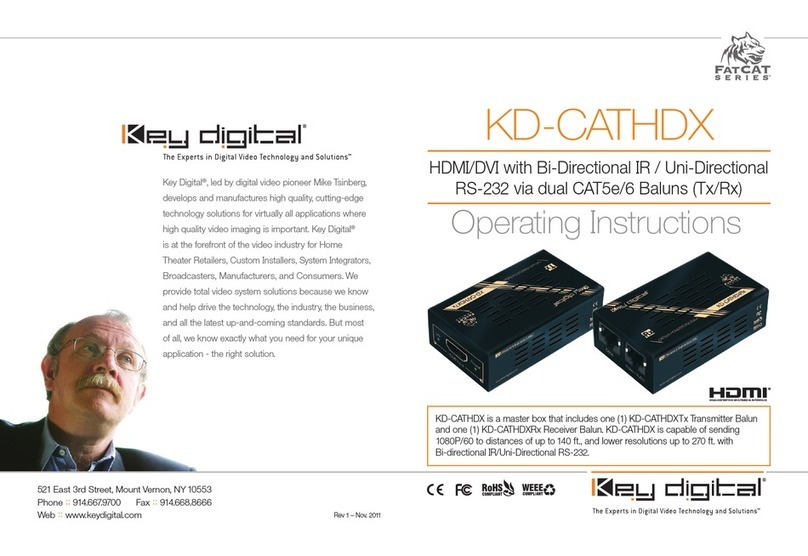
Key Digital
Key Digital FATCAT Series operating instructions
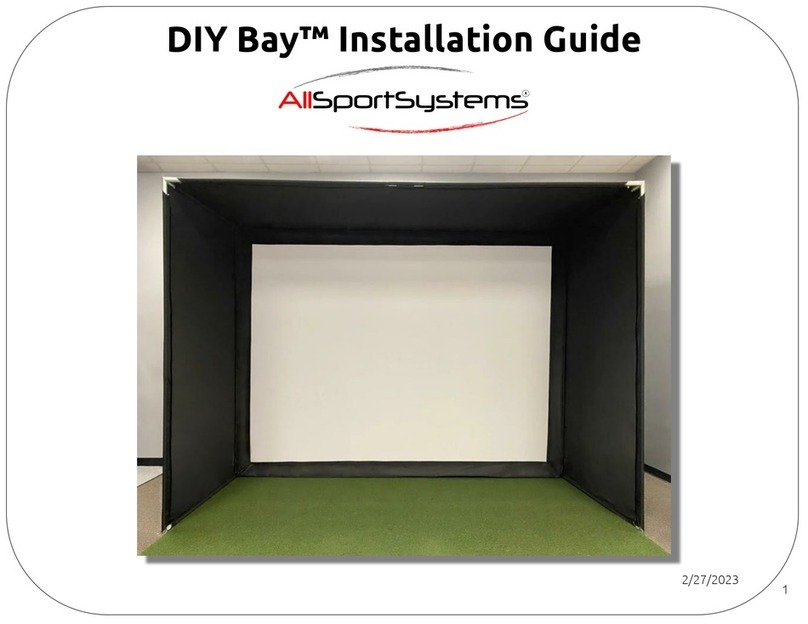
AllSportSystems
AllSportSystems DIY Bay installation guide
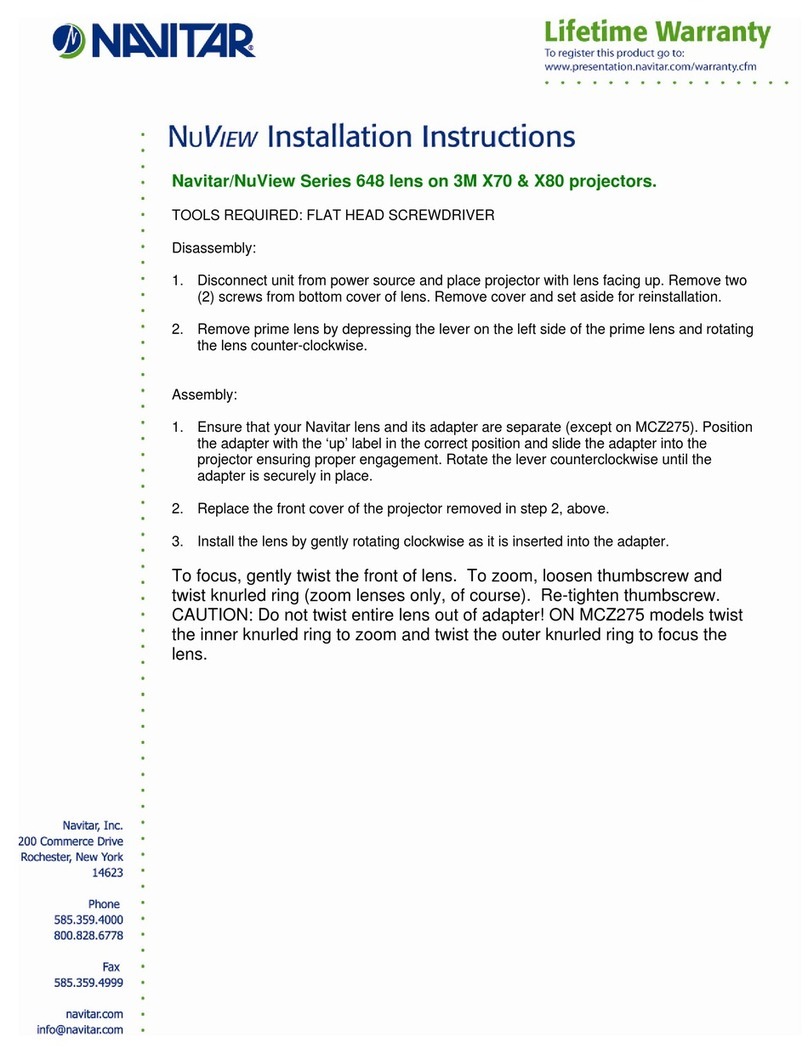
Navitar
Navitar 648MCL1028 installation instructions
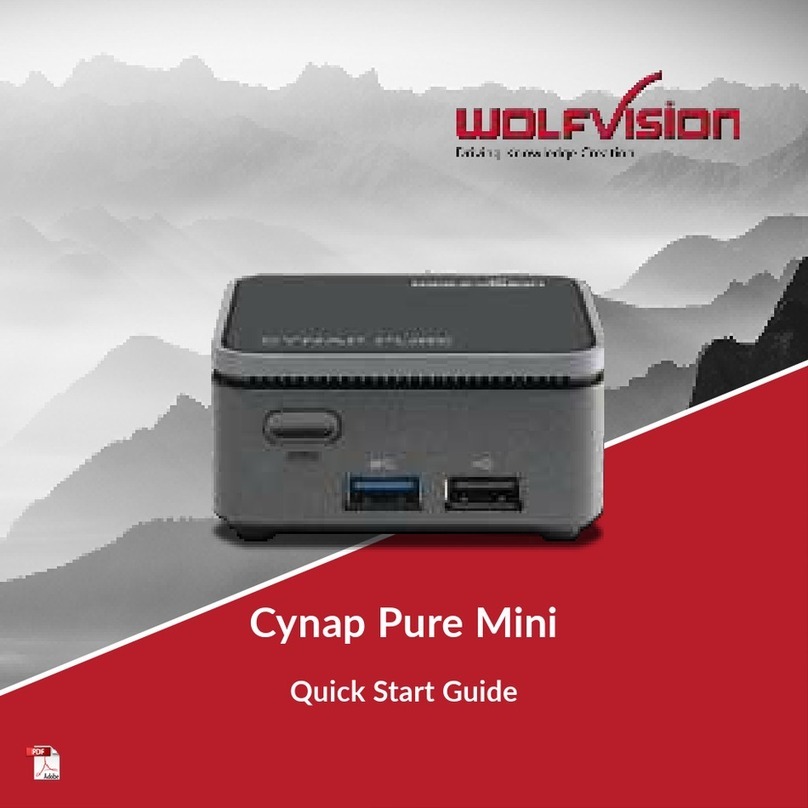
WolfVision
WolfVision Cynap Pure Mini quick start guide
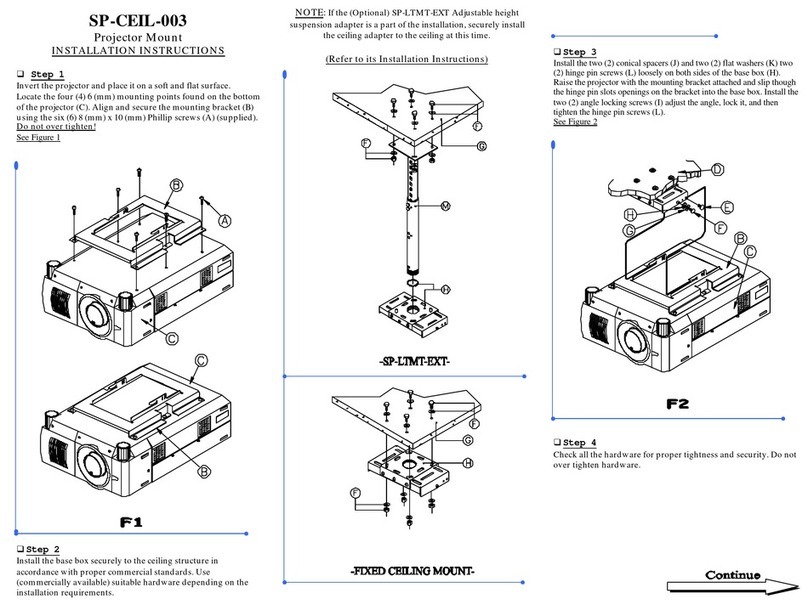
InFocus
InFocus SP-CEIL-003 installation instructions



